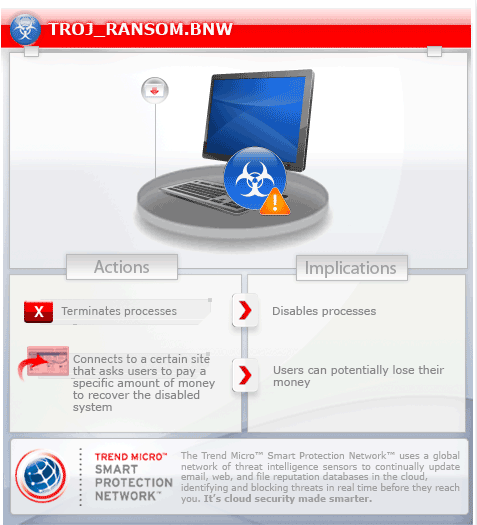TROJ_RANSOM.BNW
Trojan:Win32/Reveton.A (Microsoft); Mal/ZboCheMan-A (Sophos)
Windows 2000, Windows XP, Windows Server 2003


Threat Type: Trojan
Destructiveness: No
Encrypted: Yes
In the wild: Yes
OVERVIEW
This is a ransomware scam that pretends to be a threatening message from Scotland Yard but actually hijacks the user's computer and demands money to unlock it.
To get a one-glance comprehensive view of the behavior of this Trojan, refer to the Threat Diagram shown below.

This Trojan executes another instance of explorer.exe where it injects itself. It then opens a notepad.exe process and injects its codes into it. The injected code in notepad.exe then disables the desktop of the affected user and open a browser window connecting to a certain site.
This Trojan may be unknowingly downloaded by a user while visiting malicious websites.
It modifies the Internet Explorer Zone Settings.
TECHNICAL DETAILS
Arrival Details
This Trojan may be unknowingly downloaded by a user while visiting malicious websites.
Installation
This Trojan drops the following files:
- %User Startup%\{malware filename}.lnk - autostart component
(Note: %User Startup% is the current user's Startup folder, which is usually C:\Windows\Profiles\{user name}\Start Menu\Programs\Startup on Windows 98 and ME, C:\WINNT\Profiles\{user name}\Start Menu\Programs\Startup on Windows NT, and C:\Documents and Settings\{User name}\Start Menu\Programs\Startup.)
Other System Modifications
This Trojan adds the following registry entries as part of its installation routine:
HKEY_CURRENT_USER\Software\Microsoft\
Internet Explorer\Main
NoProtectedModeBanner = "1"
HKEY_CURRENT_USER\Software\Microsoft\
Windows\CurrentVersion\Policies\
System
DisableTaskMgr = "1"
Process Termination
This Trojan terminates the following services if found on the affected system:
- avp.exe
Web Browser Home Page and Search Page Modification
This Trojan modifies the Internet Explorer Zone Settings.
NOTES:
Upon execution, it executes another instance of explorer.exe where it injects itself. It then opens a notepad.exe process and injects its codes into it.
The injected code in notepad.exe then disables the desktop of the affected user and open a browser window connecting to the following site:
- http://{BLOCKED}.{BLOCKED}.163.204/
The site asks a user to pay a certain amount of money in order to recover the disabled system.
As of this writing, the said site is inaccessible.
SOLUTION
Step 1
Before doing any scans, Windows XP, Windows Vista, and Windows 7 users must disable System Restore to allow full scanning of their computers.
Step 2
Restart in Safe Mode
Step 3
Search and delete this file
- %User Startup%\{malware filename}.lnk
Step 4
Delete this registry value
Important: Editing the Windows Registry incorrectly can lead to irreversible system malfunction. Please do this step only if you know how or you can ask assistance from your system administrator. Else, check this Microsoft article first before modifying your computer's registry.
- In HKEY_CURRENT_USER\Software\Microsoft\Internet Explorer\Main
- NoProtectedModeBanner = "1"
- NoProtectedModeBanner = "1"
- In HKEY_CURRENT_USER\Software\Microsoft\Windows\CurrentVersion\Policies\System
- DisableTaskMgr = "1"
- DisableTaskMgr = "1"
Step 5
Reset Internet security settings
Step 6
Restart in normal mode and scan your computer with your Trend Micro product for files detected as TROJ_RANSOM.BNW. If the detected files have already been cleaned, deleted, or quarantined by your Trend Micro product, no further step is required. You may opt to simply delete the quarantined files. Please check this Knowledge Base page for more information.
Did this description help? Tell us how we did.


